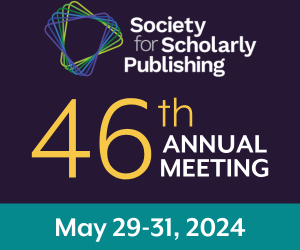Editor’s Note: Today’s post is by David Turner. David is an industry veteran in the areas around content management and content structure.
One silver lining emerging from the dark days of the pandemic is the advent of the hybrid conference. While most people prefer to attend events like the Society for Scholarly Publishing (SSP) Annual Meeting in person, sometimes you just can’t make the trip. For some, an important in-office meeting, tickets to a Run-DMC reunion concert, or a child’s school function prevent them from traveling. Others can’t get the travel budget approved and some simply just prefer not to travel. Whatever the case, a virtual attendance option opens a new realm of possibilities.
Unfortunately, the “shine” has rubbed off a bit when it comes to the hybrid event. 67% of event marketers find it challenging to maintain attendee engagement during virtual events. Virtual attendees feel as if they are an afterthought as they sit in sessions really designed for their in-person counterparts. Think about it:
- In person, you talk to the person next to you about the keynote when it ends. Most virtual attendees don’t have a forum for this kind of interaction.
- While networking happens naturally in person, getting conversations started in “planned” networking sessions online can feel forced (and downright uncomfortable).
- Virtual attendees find it awkward to jump into a conversation happening in person during a breakout session and consequently feel they don’t have the chance to have their voice heard.
- And while attending a cocktail reception from 5pm-7pm is no problem when you’re away from home, many virtual attendees find their loved ones a LOT less understanding of them being online after hours.
In response, the SSP Annual Meeting Planning Committee has addressed these challenges to create a truly AWESOME virtual experience for 2024. In addition to aligning the virtual experience with the in-person experience where we can (Keynote, plenaries, selected breakout sessions, and SSP Previews), we’re including a series of unique virtual only experiences like:
- A Virtual Registration Table where attendees will be welcomed, meet other attendees, and resolve any technical questions.
- An Ask the Speakers session where participants can interact with Keynote speaker Deborah Blum and Plenary moderator Andromeda Yelton.
- A Poster Session Livestream with tour guide Stephanie Lovegrove-Hansen where virtual attendees can chat with presenters and experience the posters just as they would in person.
- A couple of Live from the Exhibit Hall sessions that allow participants to explore booths, meet vendors, and engage in high-level discussions, just as they might in person.
- Two Breaking Down the Breakouts (BDTB) sessions for attendees to ask questions and contribute to the conversation with panelists from the Breakout sessions like Alison Denby from OUP and Miranda Walker from WK.
Furthermore, we’re eliminating forced “networking” spaces and after hours virtual “receptions” in favor of creating engagement and interaction more naturally. Finally, I’m participating as a dedicated virtual host to help virtual attendees get as much out of the Annual Meeting as possible.
On behalf of the SSP staff and AMPC, I’m excited about what is planned and encourage anyone who won’t be able to attend in-person to join us virtually. Feel free to email me at dturner@dclab.com with any questions or if you’d like to volunteer in some way. You can find out more about virtual attendance at the SSP Annual Meeting here.



